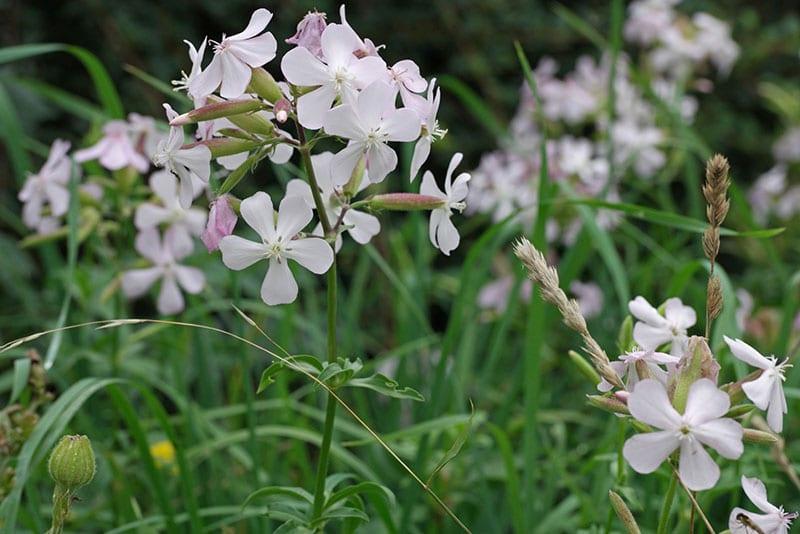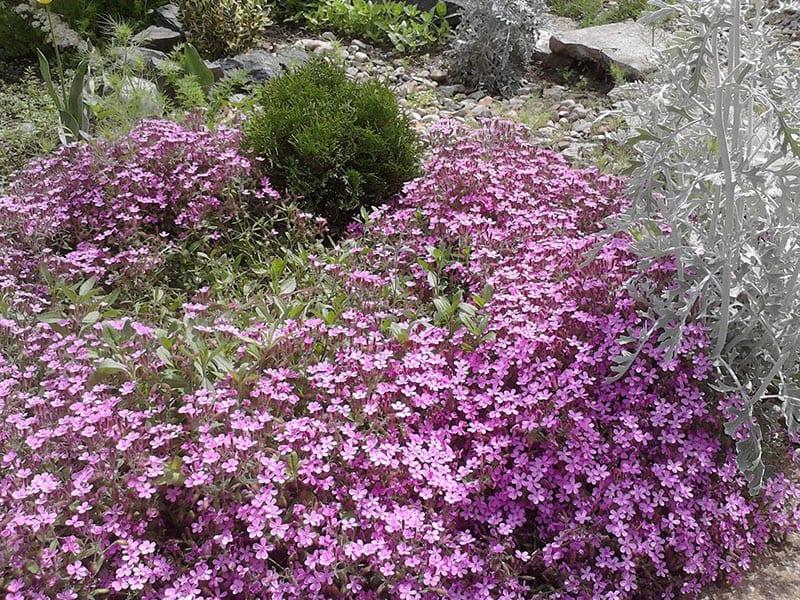Competent planting and caring for saponaria at their summer cottage
 A bright scattering of small flowers against a background of lush greenery exquisitely emphasizes the charm of the backyard landscape. To create such beauty in ourselves, we will learn how to plant and care for saponaria in the open field. The second name of the plant - soapwort, indicates its unique properties.
A bright scattering of small flowers against a background of lush greenery exquisitely emphasizes the charm of the backyard landscape. To create such beauty in ourselves, we will learn how to plant and care for saponaria in the open field. The second name of the plant - soapwort, indicates its unique properties.
The root system contains a substance that forms a foam on contact with water. It has a cleansing effect. Therefore, our ancestors actively used saponaria for bathing and washing. Today, the components of the plant are included in cosmetics, medicines and some products. In addition, the flowers fit wonderfully into the landscape design of the backyard area. Let's get to know the unique flowers better, and also learn how to grow soapwort on your site.
Saponaria in all its glory

 A powerful rhizome with many branches is hidden in the underground part of the culture. Due to its structure, the saponaria forms lush "bedspreads" that adorn flower beds or lawns. Erect shoots of a prostrate character emerge from it. Their height sometimes reaches 80 cm. The stems are bare or with many small villi. All of them are decorated with foliage located opposite each other.
A powerful rhizome with many branches is hidden in the underground part of the culture. Due to its structure, the saponaria forms lush "bedspreads" that adorn flower beds or lawns. Erect shoots of a prostrate character emerge from it. Their height sometimes reaches 80 cm. The stems are bare or with many small villi. All of them are decorated with foliage located opposite each other.
Depending on the type, it happens:
- spatulate;
- linear lanceolate;
- oval;
- broadly lanceolate.
 Moreover, the seating plates have sharp or blunt edges. During the flowering period, greens are diluted with corymbose or paniculate inflorescences. The buds are composed of five delicate petals in white, pink or purple. After successful pollination, fruits appear. They are presented in the form of a box with many obtuse black seeds.
Moreover, the seating plates have sharp or blunt edges. During the flowering period, greens are diluted with corymbose or paniculate inflorescences. The buds are composed of five delicate petals in white, pink or purple. After successful pollination, fruits appear. They are presented in the form of a box with many obtuse black seeds.
The cute soapwort (saponaria) belongs to the Clove family. In nature, it is found almost throughout the territory of Eurasia. Biologists classify over 40 species. However, only 10 of them are used in landscape design.
Medicinal

Perennial grows up to 80 cm. Buds are collected in corymbose inflorescences. Cultivated species:
- Alba Plena;
- Betty Arnold;
- Rosea Plena.
Each of them has its own unique coloring. And some have a terry bud structure.
Basilicon
 It occurs naturally on the slopes of the majestic Alps. During flowering forms soft "carpets" up to 20 cm high.
It occurs naturally on the slopes of the majestic Alps. During flowering forms soft "carpets" up to 20 cm high.
Popular varieties:
- Camilla;
- Snow Type;
- Splendas.
The buds are mostly pink in various tones. The varieties tolerate winter cold wonderfully. They reproduce by self-seeding, forming lush "thickets".
Olivana
 A new hybrid was obtained by combining dwarf and soddy saponaria. It grows up to 5 cm. It forms dense and soft floral cushions.
A new hybrid was obtained by combining dwarf and soddy saponaria. It grows up to 5 cm. It forms dense and soft floral cushions.
Lampurjee
 The cultivated form of the plant first appeared in southern Europe. The flower grows up to 40 cm. It has narrow lanceolate leaves, painted in dark green color. Nice buds form on the tops of the stems.
The cultivated form of the plant first appeared in southern Europe. The flower grows up to 40 cm. It has narrow lanceolate leaves, painted in dark green color. Nice buds form on the tops of the stems.
Any of these types will decorate the landscape of the infield.The flower rug looks great on rocky alpine slides, hanging planters and near curbs. Soapyka creates an original background for roses, peonies, lilies and decorative daisies.
Planting and caring for saponaria in an open flower bed
 In its natural environment, the flower grows on rocky ground. Therefore, when planting soapworms, the type of soil is taken into account. Lime soil is the best option. It should have an abundance of drainage components, calcium and nitrogen, because the root system of the plant does not tolerate stagnant moisture.
In its natural environment, the flower grows on rocky ground. Therefore, when planting soapworms, the type of soil is taken into account. Lime soil is the best option. It should have an abundance of drainage components, calcium and nitrogen, because the root system of the plant does not tolerate stagnant moisture.
It is advisable to mulch loose soil with fine gravel or gravel.

The place for planting saponaria and caring for it must meet three criteria:
- an abundance of sunlight;
- room for air masses;
- perfect neighborhood with plants.
When shaded, the color of the buds will lose their saturation. The petals will be pale, which will affect the decorativeness of the culture. Drafts cause temperature extremes that cause fungal infections. And tall "neighbors" can completely drown it out.
 When a place for a flower bed is chosen, they begin to grow seponaria from seeds in the open field.
When a place for a flower bed is chosen, they begin to grow seponaria from seeds in the open field.
First, prepare the ground by performing simple steps:
- remove weeds with a rake;
- plow the top layer of the earth with a shovel or hoe;
- make shallow holes.
If you plan to get a dense carpet, seeds are sown in random order. In addition, there is another way of growing soapworms in a summer cottage. Consider how this is done using seedlings in mid-March.
Sowing is carried out before winter (in October) or in spring, when the soil has warmed up enough.
Growing seedlings at home
 For business, you need small pots or a spacious container. The containers are filled with a suitable substrate over the drainage layer. The earth is moistened with a spray bottle, after which the seeds are sown. From above they are covered with a thin layer of river sand and gently watered again. The container is covered with glass or transparent film. Crops are transferred to a warm room where the temperature is maintained at + 20 ° C. In addition, there should be an abundance of diffused light.
For business, you need small pots or a spacious container. The containers are filled with a suitable substrate over the drainage layer. The earth is moistened with a spray bottle, after which the seeds are sown. From above they are covered with a thin layer of river sand and gently watered again. The container is covered with glass or transparent film. Crops are transferred to a warm room where the temperature is maintained at + 20 ° C. In addition, there should be an abundance of diffused light.
 When the first shoots appear, the film or glass is immediately removed. Crops are regularly watered with water at room temperature and the topsoil is loosened. After the formation of true leaf plates, saponaria seedlings dive, transplanting them into separate pots.
When the first shoots appear, the film or glass is immediately removed. Crops are regularly watered with water at room temperature and the topsoil is loosened. After the formation of true leaf plates, saponaria seedlings dive, transplanting them into separate pots.
14 days before planting in open ground, the seedlings are periodically taken out to the street so that it gets used to the outside air temperature.
Planting on a flower bed
 The strengthened seedlings are transferred to the garden bed when the threat of spring frost has passed. In addition, the soil should warm up properly. In most regions of the country, this period falls in mid-May.
The strengthened seedlings are transferred to the garden bed when the threat of spring frost has passed. In addition, the soil should warm up properly. In most regions of the country, this period falls in mid-May.
In the prepared area, the soil is plowed and leveled. They make holes in which the seedlings are placed at a distance of 30 cm from each other. After that, the flower bed is watered with a spray bottle.
Digging up the soil in a flower bed, it is advisable to equip a drainage layer of sand and expanded clay.
Care rules
 In order for the soapstone flower to take root in a new area, it is necessary to properly care for it. The first thing is timely watering. It is carried out as the top layer of the earth dries up. Otherwise, excess moisture will collect, which can lead to the death of the culture. If during the growing season heavy rainfall is observed, a film is stretched over the flower bed. For this, a metal frame or arcs are installed.
In order for the soapstone flower to take root in a new area, it is necessary to properly care for it. The first thing is timely watering. It is carried out as the top layer of the earth dries up. Otherwise, excess moisture will collect, which can lead to the death of the culture. If during the growing season heavy rainfall is observed, a film is stretched over the flower bed. For this, a metal frame or arcs are installed.
Saponaria is fed twice a season potash-phosphorus fertilizers... Usually, the procedure is carried out before flowering and at the end of summer. A culture planted on a nutritious soil does not need feeding. It is enough to periodically weed the plant and water it in a timely manner.
 So that weeds do not grow on the flower bed, open areas are covered with pebbles or expanded clay.Against the background of such "decor", the landings look attractive and stylish. To extend the flowering period, gardeners cut off wilted buds. Thanks to this, self-seeding of the plant is excluded.
So that weeds do not grow on the flower bed, open areas are covered with pebbles or expanded clay.Against the background of such "decor", the landings look attractive and stylish. To extend the flowering period, gardeners cut off wilted buds. Thanks to this, self-seeding of the plant is excluded.
In addition, the care and cultivation of soapworms includes planned autumn pruning. Before the onset of cold weather, the bushes are cut off, leaving only a third of the stem. In areas with severe winters, flower beds are covered with fallen leaves or spruce branches.
On one site, the plant is grown for 8-9 years. During this time, the overgrown plantings grow old and lose their decorative effect. To rejuvenate the flower bed, saponaria bushes are divided into several parts and planted in a new area.
Protection from pests and diseases
 No matter how hard we try, all plants are susceptible to disease. Moreover, they can become a “haven” for various insects. So in the thickets of soapwort, a garden scoop settles. She feeds on her seed pods. And lays eggs on the shoots. There are two ways to save flowers from a caterpillar: pick up pests with your hands or use insecticides. After treatment with a chemical, the pests die, and the saponaria again pleases the eye with its bright colors.
No matter how hard we try, all plants are susceptible to disease. Moreover, they can become a “haven” for various insects. So in the thickets of soapwort, a garden scoop settles. She feeds on her seed pods. And lays eggs on the shoots. There are two ways to save flowers from a caterpillar: pick up pests with your hands or use insecticides. After treatment with a chemical, the pests die, and the saponaria again pleases the eye with its bright colors.
Sometimes the flowers are affected by root rot and spotting of leaf plates. When signs of the disease appear, the affected specimens are removed from the flower bed. And the rest are sprayed with a fungicide solution.
 In any case, planting and caring for saponaria brings real pleasure to gardeners. After all, the plant, in principle, is unpretentious. Fits perfectly into any landscape design. It easily tolerates severe winters and pleases the eye almost all summer. Let's hurry to sow an amazing flower on our site - saponaria.
In any case, planting and caring for saponaria brings real pleasure to gardeners. After all, the plant, in principle, is unpretentious. Fits perfectly into any landscape design. It easily tolerates severe winters and pleases the eye almost all summer. Let's hurry to sow an amazing flower on our site - saponaria.